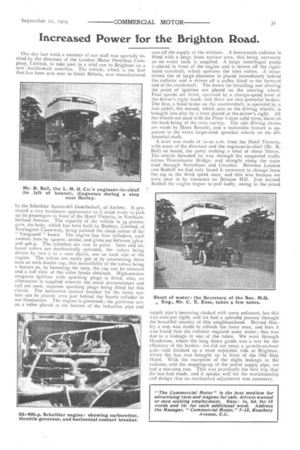Increased Power for the Brighton Road.
Page 15

If you've noticed an error in this article please click here to report it so we can fix it.
One day last week a member of our staff was specially invited by the directors of the London Motor Omnibus Company, Limited, to take part in a trial run to Brighton on a new double-deck omnibus. The vehicle, which is the first that has been sent over to Great Britain, was manufactured
by the Scheibler Automobil Gesellschaft, of Aachen. It presented a very handsome appearance as it stood ready to pick up its passengers in front of the Hotel Victoria, in Northumberland Avenue. The capacity of the vehicle is 34 passengers, the body, which has been built by Bayleys, Limited, of Newington Causeway, being painted the usual colour of the " Vanguard " buses. The engine has four cylinders, each 120MM. bore by iitornm. stroke, and gives out between 35h.p. and 4oh.p. The cylinders are cast in pairs. Inlet and exhaust valves are mechanically operated, the valves being driven by two 2 to I cam shafts, one on each side of the engine. The valves are easily got at by unscrewing three nuts on each double cap, this accessibility of the valves being a feature as, by loosening the nuts, the cap can be removed and a full view of the valve heads obtained. High-tension magneto ignition with sparking plugs is fitted, also, an alternative is supplied wherein the usual accumulators and coil are used, separate sparking plugs being fitted for this circuit. The horizontal contact breaker for the latter system can be plainly seen just behind the fourth cylinder in our illustration. The engine is governed; the governor acts on a valve placed at the bottom of the induction pipe and
cuts off the supply ol the mixture. A honeycomb radiator is fitted with a large front surface area, this being necessary as no water tank is supplied. A large centrifugal pump is placed in front of the engine and is driven off the righthand camshaft, which operates the inlet valves. A strapdriven fan of large diameter is placed immediately behind the radiator and is driven off a pulley fitted to the forward end of the crankshaft. The levers for throttling and altering the point of ignition are placed on the steering wheel. Four speeds are fitted, operated by a change-speed lever at the driver's right hand, and there are two powerful brakes. The first, a band brake on the countershaft, is operated by a foot pedal; the second, which acts on the driving wheels, is brought into play by a lever placed at the driver's right. All the wheels are shod with the Peter Union solid tyres, those on the back being of the twill variety. The side driving chains are made by Hans Renold; and a noticeable feature is apparent in the extra large-sized sprocket wheels on the differential shaft.
A start was made at 10.20 a.m. from the Hotel Victoria, with some of the directors and the engineer-in-chief (Mr. R. Bell) on board, the party making a total of about fifteen. The vehicle threaded its way through the congested traffic across Westminster Bridge, and straight along the main road through Streatham and Croydon. Between London and Redhill we had only found it necessary to change from the top to the third speed once, and this was because we were shut in by tramcars on Brixton Hill. Just beyond Redhill the engine began to pull badly, owing to the petrol supply pipe's becoming choked with some sediment, but this was soon put right, and we had a splendid journey through the beautiful country of this neighbourhood. Beyond HotIcy a stop was made to refresh the inner man, and here it was found that the radiator required some water; this was due to a leakage in one of the tubes. We went through Handcross, where the long down grade was a test for the efficiency of the brakes--we (!icl not essay a 32-mile-an-hour gait—and finished up a most enjoyable ride at Brighton, where the bus was brought up in front of the Old Ship Hotel. With the exception of the slight leakage in the radiator, and the stopping-up of the petrol supply pipe, we had a eon-stop run. This was practically the first trip that the bus had made, and it speaks well for the workmanship and design that no mechanical adjustment was necessary.
















